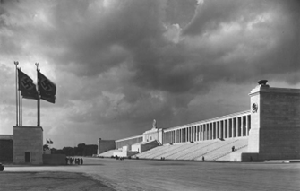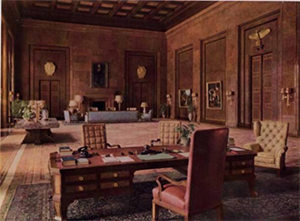By Rowanne Reifman

SAN DIEGO — Historically, governments have frequently used architecture to communicate power and authority. During the Nazi rule of Germany, Hitler, and his head architect Albert Speer, were able to communicate power and oppression through the structures they built. By using the communication theory of environmental comfortability, we can better understand how the Nazis successfully communicated power and oppression through the architecture they created.
The communication theory of environmental comfortability discusses how specific environments and architectural styles can make a person comfortable or uncomfortable and, based on that comfort, determine how much a person will engage with that environment. Two examples of Nazi architecture, Zeppelin Field and Hitler’s Chancellery prove this theory.

Zeppelin Field was an ample outdoor space where Hitler held his rallies. Speer based Zeppelin field off of the Pergamon Altar, an ancient Greek building meant to honor the Gods and solidify the Attalids’ reign over Greece after the fall of Alexander’s empire. One could conclude why Speer based the Zeppelin field on the Pergamon Altar. One reason could be that Hitler’s choice of architectural style was neoclassical, as he believed that neoclassical styles communicated a powerful government that was structured and in control. However, there could also be a deeper meaning, and the overall message is evident with the Zeppelin Field.
Like the Attalids, Hitler wanted to send a message that a new power was taking hold in Germany. By referencing a historical Altar and making it into a rallying place, Hitler and Speer were directly encouraging the people of Germany to be excited about this new era and change of power. Since Zeppelin Field is outdoors, it encourages crowds to cheer and get loud to show their support for the rising party. The crowd themselves are faced with watching the Nazi soldiers march through. Across the field, where the crowd is also facing, are Nazi flags posted on each side, tall and visible. Above them, planes would fly through. The clean straight lines of the building communicate a sense of control, stability, and strength as if to say, “The Nazi party is strong and here to stay.
All of this encourages a sense of nationalism and pride, which is what Hitler wanted, and this connects back to communication theory because the environment Speer created actively engages the spectators. If the crowd feels comfortable and confident in their space, their internal feelings of confidence in their government may be stronger. Environmental comfortability theory also discusses how people can make an environment more or less comfortable. So, if the crowd is loud, cheering, and happy, other people will feel the same way too.

However, not all the architecture the Nazis built was intended to be inviting. Hitler’s Chancellery is infamously an uncomfortable place. Hitler wanted a place to hold his rallies to communicate a new power shift in Germany and a new headquarters bigger and better than previous governmental buildings in Germany. To enter Hitler’s Chancellery, one would need to arrive via vehicle. Once pulled into the only entrance, one would be greeted with gigantic walls that made one feel enclosed and trapped in the space, with the door heavily guarded. Having soldiers with heavy weaponry guarding the door communicates that anyone granted entry should behave at their best, as they are special enough to have access to such a building and the people inside.
Once in the building itself, one would need to walk through long hallways to reach his office, forcing the person to be mentally prepared to meet Hitler. One of these hallways was an imitation of the Hall of Mirrors in Versailles, which was longer than the original. By creating a larger Hall of Mirrors, Hitler attempted to say that he has more money and power than a king. In a separate hallway, the floors were slippery, making the person cautious and anxious. Once in Hitler’s office, the walls were once again large-scale, with a large fireplace, desk, and chair. Immediately, one feels small and knows that the person with the power in the room is Hitler.
When applying communication theory to this building, the environment can make a person uncomfortable. It may lead them to want to disengage, possibly even wanting to leave as soon as possible. Having such large scales everywhere communicates how much power the person in charge has and how little power others have. Additionally, making Hitler’s private office so hard to get to discourages people from seeking him out and wanting to talk with him, while simultaneously communicating how high his status is.
Other scholars have also argued that architecture can be used to communicate power. In Bawesh Pradhan’s dissertation, “Architecture as Manifestations of Power,” he argues that architecture “holds an extremely powerful ability to govern how people think and what they can be made to think.” He uses historic and modern Indian architecture to support his claim. Scholars and architects also use the example of Donald Trump, who uses architecture to convey dominance and power in the U.S.
Like Hitler, Trump has denounced modern architecture numerous times and instead encourages the promotion of neoclassicism. In an article published in January by The Art Newspaper, architects apart from the American Institute of Architects denounced Trump’s executive order to promote federal civic architecture, saying, “the executive order is meaningless. This is an effort to use culture to send coded messages about white supremacy and political hegemony” (Gareth Harris, 2025). When relating these arguments to communication, it is evident that architecture is a powerful way to display power dynamics and control over groups of people.
The Nazis were able to communicate oppression and authority through the structures they created successfully, and depending on the building, they would evoke certain emotions in people. Today, we have another authoritative figure in office in the United States, who, instead of using the Nazis philosophy as a warning is seemingly using it as inspiration. Architects and art historians must ask how to counteract Trump and his denunciation of modernism. The answer may ironically lie within the history of Nazis and architecture. If the Nazis were able to communicate power through buildings successfully, how can we, in turn, use architecture to communicate hope and community? How can we use architecture and art as a way to counter authoritarianism? The answer may lie in history, but only time will tell.
Bibliography
Christiaens, Karin E. “Smarthistory – The Pergamon Altar.” Accessed April 27, 2025. https://smarthistory.org/the-pergamon-altar/.
Harris, Gareth. “Architects Denounce Trump’s Call for ‘Traditional and Classical’ Architecture.” The Art Newspaper – International Art News and Events, January 22, 2025. https://www.theartnewspaper.com/2025/01/22/architects-denounce-trump-traditional-classical-architecture-executive-order.
Knapp, Mark L., and Anita L. Vangelisti. Interpersonal Communication and Human Relationships, 1996.
“New Reich Chancellery.” Accessed April 27, 2025. https://www.liberationroute.com/pois/843/new-reich-chancellery.
Pradhan, Bawesh. “Architecture as Manifestations of Power.” unknown, June 15, 2012. https://www.researchgate.net/publication/357172130_Architecture_as_Manifestations_of_Power.
The White House. “Promoting Beautiful Federal Civic Architecture – The White House,” January 21, 2025. https://www.whitehouse.gov/presidential-actions/2025/01/promoting-beautiful-federal-civic-architecture/.
*
Rowanne Reifman is an art major at San Diego State University. This essay was written as a class paper.